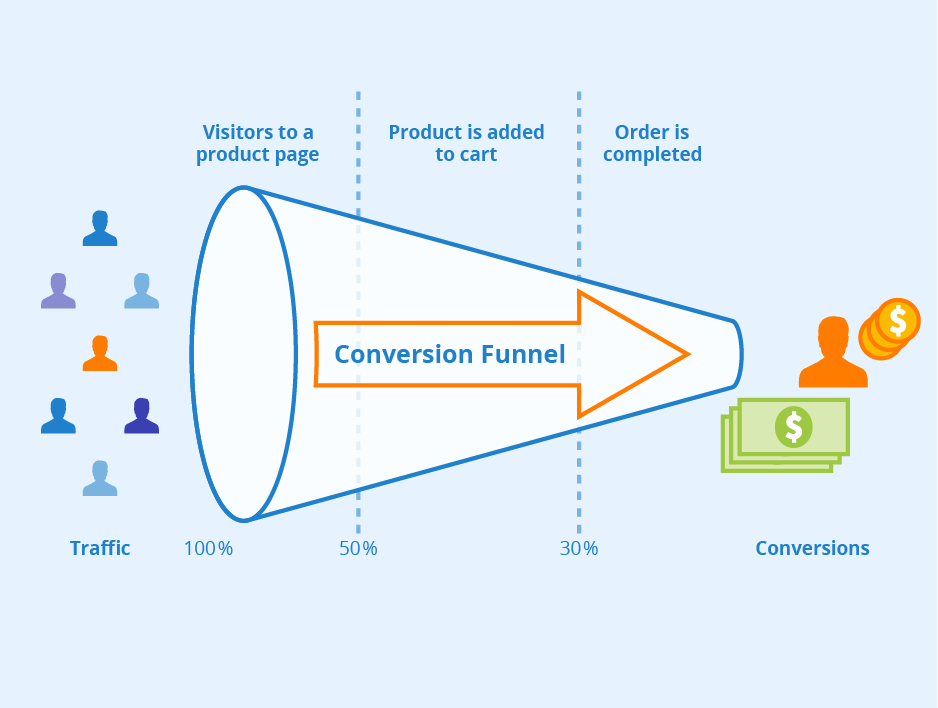Looking for ways to optimise your conversions through the funnel? In this article, I’ll talk about conversion funnels, why they’re so important and ways to improve it. By the end, you will have the skills to boost sales and make your sales funnel the best it can be.
What is a conversion funnel?
A conversion funnel is an eCommerce term used to describe a consumer’s journey from the first interaction with your advertising or organic campaign to the final point of conversion – the sale. The “funnel” gradually gets smaller as a customer travels through.

Why is it important?
Understanding the conversion funnel is crucial in understanding a consumer’s thought process. If you can think like a customer, you’ll know what kind of habits they have and can use more targeted and personalised marketing techniques to guide them to those final conversions.
A successful conversion funnel translates into a healthy profit for your business.
How to create and optimise your funnel
1. Outline the process
The conversion funnel can be thought of as having three divisions: the upper funnel, middle funnel and lower funnel.
- Upper funnel: This describes users who have just searched for a product and don’t know a lot about it. They search through several brands as they try to figure out what exactly they need.
- Middle funnel: These consumers know more about the product and even know about popular brands and technical features of the product. They know what they want and will turn away from brands that do not meet their specifications.
- Lower funnel: These potential buyers are ready to purchase but might need a nudge. They have favourite brands and look for more specific information about the product from customer reviews about it. Consumers at this stage of conversion can be triggered to make a sale through remarketing techniques that get them off the fence.
To be efficient at every stage of the conversion process, aim to convince your customer to go a step further in each stage of the conversion funnel. The popular AIDA model is an excellent tool to divide and conquer the funnel at each stage.
AIDA stands for Awareness, Interest, Desire and Action. These are the responses you want to evoke from your consumers at specific stages of the conversion funnel.
- Awareness
For Upper Funnel consumers, you want to create Awareness of the product. There are several ways to achieve this, including social media, organic search, blogging, and pay per click (PPC) campaigns.
- Interest
Now your consumers have made it to your landing page. What measures have you put in place to keep them there? What stops them from tagging out as soon as they arrive? Some strategies include offering consumers a discount or special offer in exchange for their contact information. For instance, they can sign up for an account on your site to benefit from free shipping. These techniques are also known as lead magnets.
- Desire
By this stage, you need to convince your consumer to trust your brand. The aim is for them to desire to choose your brand over others’. Customers can be described as being in the ‘Middle funnel’ during this process; they would value more information about your brand, which you can provide through email marketing. This marketing technique is more targeted to your consumer’s needs and will keep them engaged.
- Action
This is when you want to provide a trigger which pushes your customer to take the final step of making a purchase. That ‘push’ is usually described as a Call to Action or CTA for short. It could take the form of an attractive discount or giving the user a limited amount of time during which they can benefit from a special offer.
This creates a sense of urgency that can be hard for them to resist.
2. Set up conversion goals
Now that you’ve laid out a plan for guiding your users through the conversion funnel, you want to know how well those plans are performing. An excellent tool for evaluating your funnel is Google Analytics. Use this tool to set conversion goals to give you a good idea of whether your conversion strategies are succeeding or not.
To be thorough, set up goals for each stage of your funnel and significant conversions. Conversion goals could be anything from signing up for a mailing list to downloading resources.
After setting up your goals, your site will accumulate user information for analysis in Google Analytics, allowing you to figure out where you can make improvements.
3. Identify weak points to optimise
Another useful feature of Google Analytics is the “Funnel Visualization” report. It helps you to analyse exactly which parts of your funnel are causing your customers to abandon the funnel altogether. In other words, it gives you information about your site’s abandonment rate. Furthermore, it shows you where they go next.
This will show you what might be distracting your users from going through the next stage of your funnel so that you can determine what needs fixing and how to fix it.
4. Use data to justify changes
Evidence-based action is the way to go to ensure optimisation of your conversion funnel. A heat map is a great way to visualise where most of your visitor traffic is going. It helps you to make informed decisions concerning what to change on your page to direct your visitors to the desired destination.
5. Use split testing
Split testing – also known as A/B testing is a neat way to test your conversion techniques by creating two varying forms of a page and analysing them to see which one is more successful at conversion.
6. Consider automation to improve efficiency
Autoresponder emails help you to remind your customers to revisit your page. It’s an efficient way to maintain a lifeline of communication with your buyers to encourage them to repeat purchases in the future. Avoid bombarding them with excessively frequent emails, and they will be less likely to unsubscribe from your mailing list.
There are numerous strategies available for optimising your conversion funnel. Depending on your business, tailor your conversion path in response to how well it leads to conversions to yield valuable increases in your conversion rates. The more users that convert at each stage of your funnel, the more buyers you obtain at the very end.
7. Let an Adzooma Marketplace agency take care of it
Sometimes, you just don’t have the resources to tinker with your conversion funnel and we understand. It’s at times like that why we created Adzooma Marketplace—to provide a connection between potential clients and agencies who can help them. Our list of agencies that specialise in CRO are at hand to get your funnel into shape and get those conversions flowing through.




